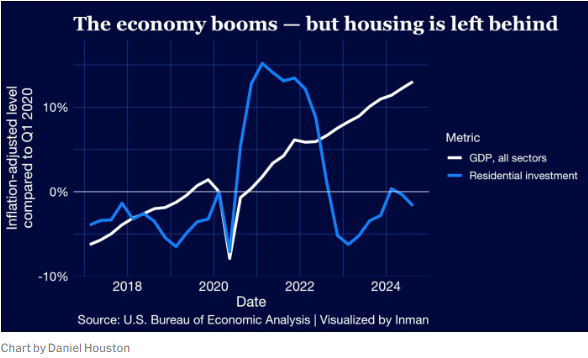The nation's real gross domestic product grew at an annual rate of 2.8% in the third quarter of the year. But with falling sales and tapering price growth, agents could be forgiven for feeling left out.

New data released earlier this month confirms that growth remains fast-paced in most sectors of the economy, even as housing continues to be left in the dust.
The U.S. Bureau of Economic Analysis reports that the nation’s real gross domestic product — an inflation-adjusted measure of total economic output — grew at an annual rate of 2.8 percent in the third quarter of the year.
Real estate agents watching this hot run could be forgiven for feeling left out.
The brokerage industry has been plagued by plunging sales and tapering price growth that has left broker’s fees stagnant even during a period when most other sectors have enjoyed robust gains.
And new housing construction — on a track to recovery as recently as the opening weeks of this year — has since taken a turn for the worse as well.
These factors contribute to an ongoing housing contraction that is largely unique in size and scope in this otherwise healthy economy.
In this week’s report, Intel breaks down the weak housing numbers within an otherwise strong GDP release.
Left behind
Within the GDP numbers, the government tracks the performance of each sector.
And the key number for the housing industry is a category known as private residential fixed investment, which makes up 3 percent to 5 percent of total U.S. economic output.
This housing-centric component of GDP primarily includes:
Broker’s commissions on residential sales
Construction of new residential structures
Spending on improvements to residential buildings
And we see in the chart below just how much this industry’s present-day output is lagging compared to other sectors.
The blue line — which had raced ahead of the broader economy during the early pandemic-era housing boom — now rests 2 percent below its seasonally adjusted level from the first quarter of 2020, after accounting for inflation.
Meanwhile, other sectors of the economy have made strong and steady inflation-adjusted progress.
Percent change since first quarter 2020
Real U.S. gross domestic product, all sectors: +13%
Real private residential fixed investment: -2%
The diverging path that real estate has taken becomes even more apparent when looking at what’s happened just since the start of 2022, when newly rising mortgage rates set into a motion a sharp contraction in housing industry activity.
Percent change since fourth quarter 2021
Real U.S. gross domestic product, all sectors: +6%
Real private residential fixed investment: -13%
Over this period, we observe that the contraction in housing has been twice as steep as the economic boom that has occurred across other sectors.
And while the housing industry has made some strides toward a nascent recovery, those efforts suffered a setback in the spring and summer of 2024.
Inside a housing contraction
One thing that the data makes clear is that the government’s broad estimate of housing output reflects far more than just home sales.
If that were all that was driving the health of the housing industry, then the whole sector would be in real trouble.
But we see instead that this measure of private residential fixed investment — represented by the blue line in the chart below — is closely linked to homebuilder activity in yellow.

We know from the National Association of Realtors that that sales of existing single-family homes are still around 30 percent below pre-pandemic levels.
So how can the industry’s output be down only 2 percent in that same time?
For one thing, after a particularly sharp downswing in new single-family projects throughout 2022, the homebuilding sector really is back near its levels from before the pandemic upended the economy.
For another, home-price growth from the early pandemic appears to largely be holding up, which has helped soften the blow to brokerages from the steep decline in sales of existing homes.
Percent change since February 2020
Construction permits authorized, single family: -2%
Existing home sales, single family: -31%
Case-Shiller home price index, above inflation: +28%
Note how, from a broker’s commission perspective, the sharply lower level of home sales since the start of the pandemic has been almost entirely offset by the rise in prices, even after accounting for inflation over that period.
But looking only at the period since the pandemic boom started to go bust, however, produces a starker divide.
Percent change since December 2021
Construction permits authorized, single family: -16%
Existing home sales, single family: -36%
Case-Shiller home price index, above inflation: +2%
In the end, no matter how it’s sliced, the housing contraction has been very real. It’s driven by a huge drop in home sales and a significant decline in homebuilding activity, which have yet to fully recover. It’s been offset only slightly by home price growth over the past couple years in particular.
And it’s happened against the backdrop of an economy that has been able to grow at a healthy clip — with or without real estate.
By Daniel Houston
Source: https://www.inman.com/2024
Image: https://www.freepik.com/


Comentarios